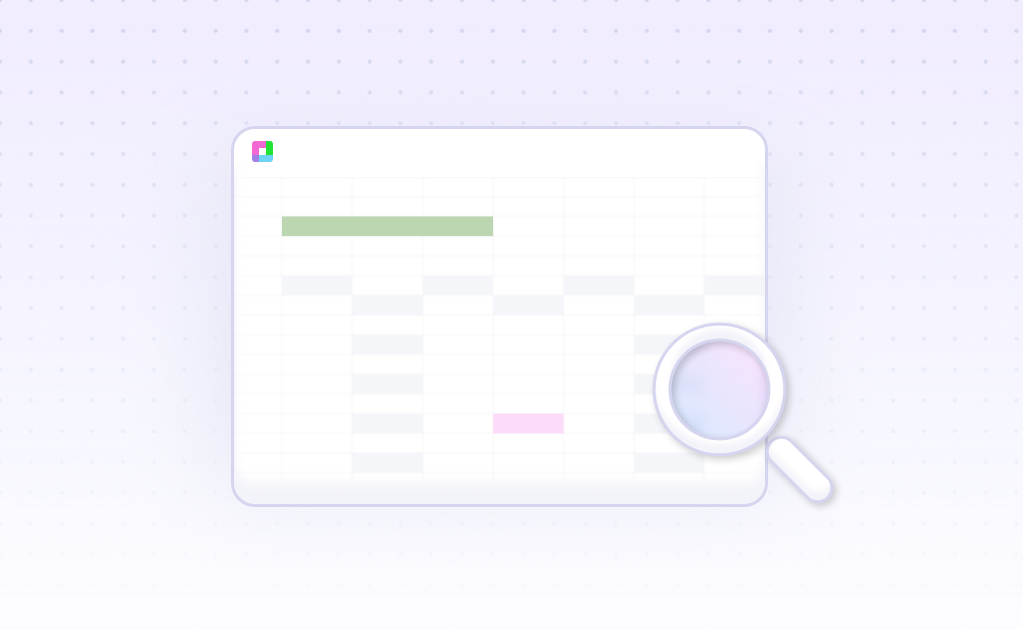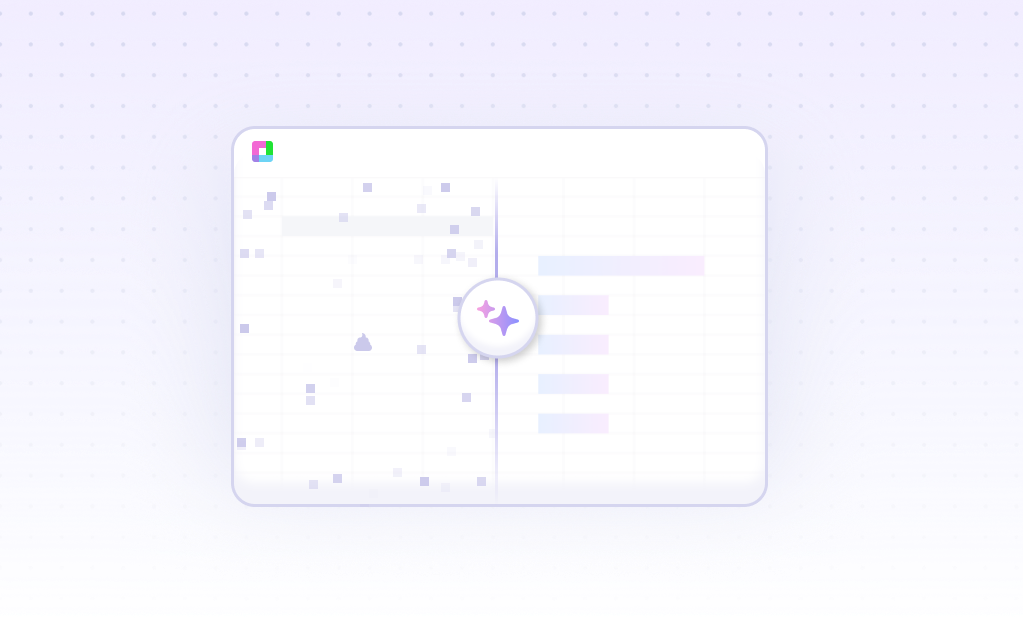
Portfolio optimization is the art and science of constructing investment portfolios that maximize expected returns while minimizing risk. In today's volatile markets, traditional spreadsheet methods fall short of handling the complex calculations and real-time data analysis required for effective portfolio management.
With Sourcetable's AI-powered analysis tools, financial professionals can now perform sophisticated portfolio optimization and asset allocation strategies that were once reserved for institutional investors with expensive software suites.
Why Use AI for Portfolio Optimization?
Traditional portfolio analysis requires complex mathematical models and extensive data processing. Sourcetable simplifies this with intelligent automation.
Modern Portfolio Theory Implementation
Automatically calculate efficient frontiers, Sharpe ratios, and optimal asset weights using proven mathematical models without complex formulas.
Risk-Return Analysis
Visualize the relationship between portfolio risk and expected returns with dynamic charts that update as you adjust allocations.
Real-Time Rebalancing
Monitor portfolio drift and receive AI-powered recommendations for rebalancing based on market conditions and your risk tolerance.
Scenario Analysis
Test your portfolio performance under different market conditions with Monte Carlo simulations and stress testing capabilities.
Correlation Analysis
Identify asset correlations and diversification opportunities to reduce portfolio risk without sacrificing returns.
Performance Attribution
Break down portfolio performance by asset class, sector, and individual holdings to understand what's driving your returns.
Real-World Portfolio Optimization Examples
Example 1: Retirement Portfolio Optimization
A 45-year-old professional wants to optimize their retirement portfolio with a 20-year investment horizon. Their current allocation is heavily weighted toward growth stocks, but they want to gradually shift to a more conservative approach as they near retirement.
Challenge: Balance growth potential with risk reduction over time while maintaining adequate diversification.
Sourcetable Solution: Using AI-powered analysis, we can:
Example 2: Institutional Endowment Optimization
A university endowment fund needs to balance long-term growth with annual spending requirements. The fund targets a 5% annual distribution while preserving purchasing power over time.
Challenge: Maximize long-term returns while ensuring liquidity for annual distributions and managing downside risk.
Sourcetable Solution:
Example 3: ESG-Focused Portfolio Construction
An investment advisor wants to create portfolios that meet clients' environmental, social, and governance (ESG) criteria while maintaining competitive risk-adjusted returns.
Challenge: Balance ESG objectives with traditional portfolio optimization metrics like return, risk, and diversification.
Sourcetable Solution:
How Portfolio Optimization Works in Sourcetable
Our AI-powered approach simplifies complex portfolio analysis into an intuitive workflow that any finance professional can master.
Import Your Data
Upload portfolio holdings, historical prices, and benchmark data from CSV files or connect directly to your data sources. Sourcetable automatically formats and validates your investment data.
Define Your Objectives
Set your investment goals, risk tolerance, and constraints. Choose from preset optimization models or customize parameters for your specific needs.
AI-Powered Analysis
Our algorithms calculate optimal asset weights using modern portfolio theory, risk parity, or custom optimization objectives. The AI handles complex mathematical calculations automatically.
Visualize Results
View efficient frontiers, risk-return scatter plots, and allocation charts. Interactive visualizations help you understand the trade-offs between different portfolio configurations.
Implement & Monitor
Export optimized portfolios and set up monitoring alerts. Track performance, rebalancing needs, and risk metrics with automated reporting.
Portfolio Optimization Use Cases
Discover how different professionals use Sourcetable for portfolio optimization across various scenarios and investment strategies.
Wealth Management Firms
Optimize client portfolios based on individual risk profiles, time horizons, and financial goals. Scale personalized portfolio management across hundreds of clients.
Family Offices
Manage complex multi-generational wealth with sophisticated asset allocation strategies, tax optimization, and liquidity planning.
Pension Funds
Optimize long-term asset allocation to meet future liabilities while managing contribution requirements and regulatory constraints.
Corporate Treasury
Manage corporate cash and short-term investments with optimal allocation strategies that balance liquidity needs with return objectives.
Investment Committees
Support investment decision-making with data-driven analysis, scenario modeling, and risk assessment for institutional portfolios.
Financial Advisors
Enhance client presentations with professional portfolio analysis, demonstrate value through optimization, and streamline portfolio construction.
Advanced Portfolio Optimization Techniques
Beyond basic mean-variance optimization, Sourcetable supports sophisticated techniques used by institutional investors and quantitative analysts.
Black-Litterman Model
Incorporate market views and investor confidence levels into portfolio optimization. The Black-Litterman model starts with market equilibrium assumptions and adjusts based on your specific insights and convictions.
Risk Parity Strategies
Allocate risk equally across portfolio components rather than capital. This approach can provide better diversification and more stable returns across different market environments.
Factor-Based Optimization
Optimize portfolios based on exposure to risk factors like value, momentum, quality, and size rather than individual securities. This approach provides more robust and explainable portfolio construction.
Dynamic Hedging Strategies
Implement sophisticated hedging strategies using options and futures to protect portfolio value while maintaining upside potential. Model complex payoff structures and optimize hedge ratios.
Portfolio Optimization FAQ
What's the difference between portfolio optimization and simple diversification?
Portfolio optimization uses mathematical models to find the best combination of assets that maximizes expected return for a given level of risk, or minimizes risk for a target return. Simple diversification just spreads investments across different assets without considering correlations, volatility, or optimal weights.
How often should I reoptimize my portfolio?
The frequency depends on your investment strategy and market conditions. Most institutional investors reoptimize quarterly or semi-annually, while tactical strategies may require monthly analysis. Sourcetable can help you set up monitoring alerts to identify when rebalancing becomes necessary.
Can I include alternative investments in my optimization analysis?
Yes, Sourcetable supports optimization across all asset classes including real estate, commodities, private equity, and hedge funds. You can input historical returns, volatility estimates, and correlation data for any investment type.
How does Sourcetable handle transaction costs in optimization?
Our optimization models can incorporate transaction costs, bid-ask spreads, and trading constraints to provide more realistic portfolio recommendations. This helps balance the benefits of rebalancing against the costs of trading.
What if I have specific constraints like ESG requirements or regulatory limits?
Sourcetable's optimization engine supports custom constraints including ESG scores, sector limits, individual position sizes, and regulatory requirements. You can define multiple constraints simultaneously while optimizing for your risk-return objectives.
How accurate are the expected return forecasts used in optimization?
Expected returns are inherently uncertain, which is why we recommend using multiple scenarios and stress testing. Sourcetable provides tools for sensitivity analysis and robust optimization techniques that account for forecast uncertainty.
Can I optimize portfolios using different risk measures beyond standard deviation?
Yes, we support various risk measures including Value at Risk (VaR), Conditional Value at Risk (CVaR), maximum drawdown, and semi-variance. You can choose the risk metric that best aligns with your investment philosophy and client needs.
How does portfolio optimization work with tax considerations?
Sourcetable can incorporate after-tax optimization by considering different tax rates for various asset classes, capital gains implications, and tax-loss harvesting opportunities. This is particularly important for high-net-worth individuals and taxable accounts.
Frequently Asked Questions
If your question is not covered here, you can contact our team.
Contact Us




